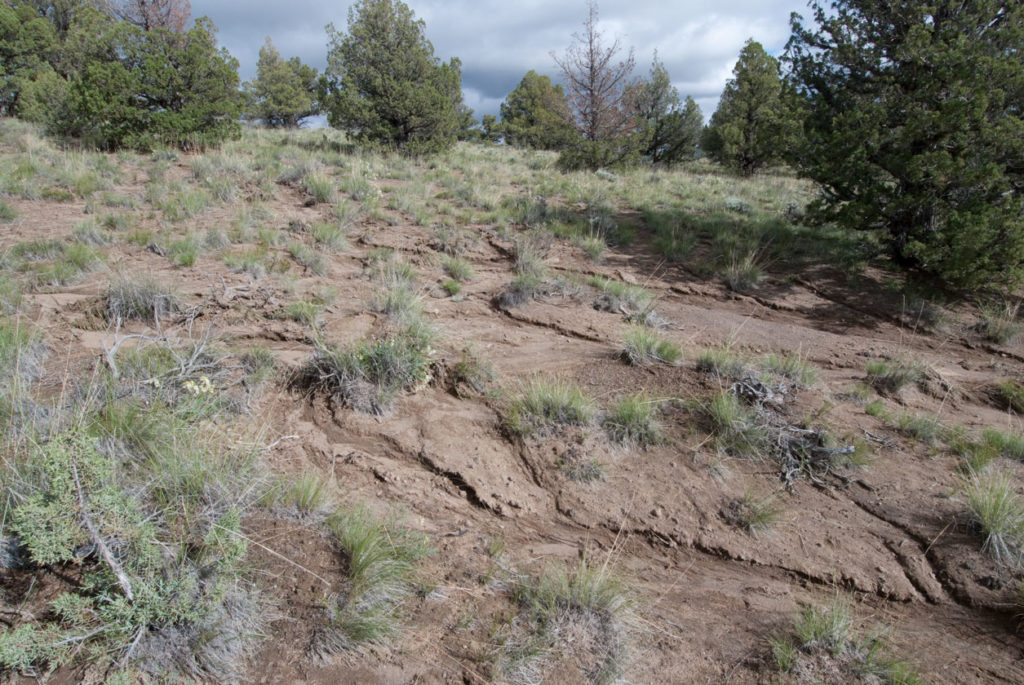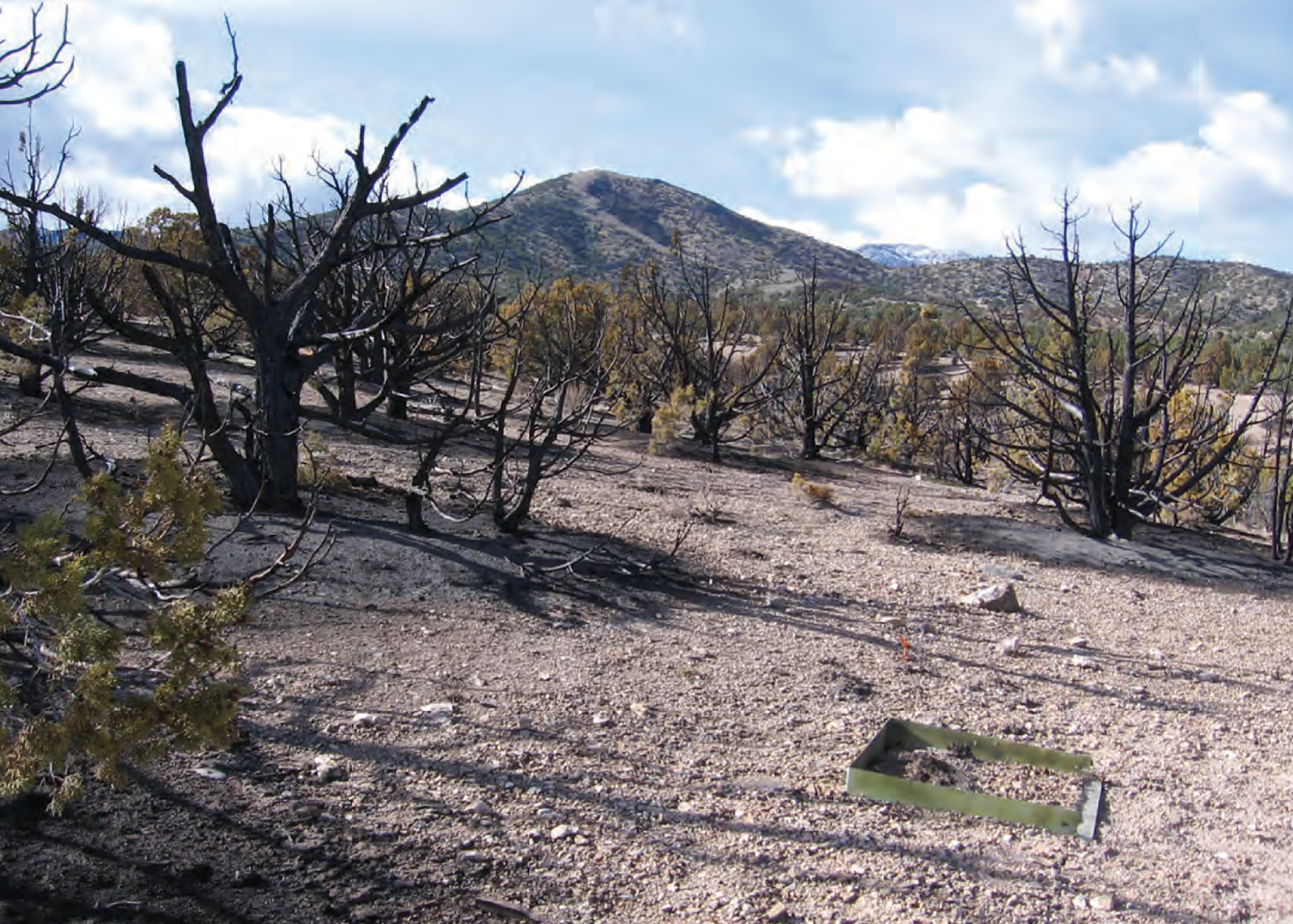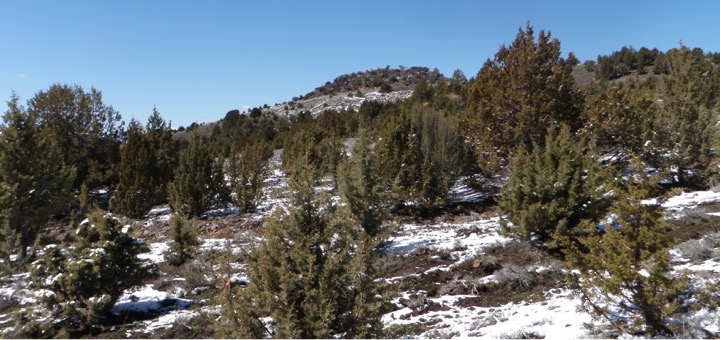Pinyon-Juniper Encroachment: Effects on Hydrology

Key Points
- Competition from encroaching pinyon-juniper woodland reduces understory vegetation, increasing bare ground and the potential for greater water runoff and erosion.
- Trees uptake large amounts of water through expansive roots, which decreases water available for shrubs and herbaceous species.
- Woodland expansion influences the formation of snowpack and therefore affects the storage and delivery of water.
- Removal of encroaching trees can have significant effects towards increasing water availability for understory plants.
What is pinyon-juniper encroachment?
Pinyon-juniper encroachment is the expansion of pinyon-juniper woodlands into ecosystems that historically were shrublands or grasslands. These tree species have increased in abundance due to fire suppression, land use and favorable climate. A significant portion of this encroachment occurs in sagebrush rangelands and affects many processes within these ecosystems.
What is hydrology?
Hydrology is the study of the distribution, movement and properties of water and its interaction with the environment. This includes the relationships of water with soil, organisms and landscapes.

Changed water availability and movement
Conversion of sagebrush ecosystems to pinyon juniper woodlands affects hydrologic processes and water availability by altering understory vegetation structure and ground cover. Trees uptake large amounts of water through expansive root systems, which reduces soil water availability for shrubs and herbaceous species in the spaces between the tree canopies. Competition for water and other resources, such as nutrients and sunlight, between trees and other plants commonly results in reduced understory plant cover and increases the amount and connectivity of bare ground. With greater patches of bare ground and fewer understory plants to intercept water and aid in soil absorption, water runoff increases, leading to greater soil erosion. With increasing encroachment, sagebrush rangelands become more susceptible to soil and water loss and are more likely to become degraded over time.
The larger size of trees, in relation to shrubs, influences how snow is distributed in an ecosystem, which further alters water availability on the surface and in the soil. The distribution of snowdrifts (i.e., big heaps of snow piled up due to wind) is highly varied in shrublands due to the constant redistribution of snow by winds into larger drifts that melt more slowly. A slower melting of snow results in ecosystem water availability lasting longer into the growing season. Tree cover, however, reduces wind, resulting in a more even distribution of snow that melts earlier in the season. This can lead to more water stress in these semi-arid ecosystems where water is already limited. Research has found that water availability from snowmelt is reduced by as much as nine days in a pinyon-juniper woodland compared to a sagebrush ecosystem.

High-severity fires, which are more likely with higher fuel loads from pinyon-juniper encroachment, can further alter the vegetation and have hydrologic consequences. The loss of vegetation in both the overstory and understory reduces water infiltration, increasing runoff and erosion. Additionally, burning of vegetation may alter snow accumulation because post-fire landscapes have greater solar radiation, which increases snowmelt rates and reduces water availability earlier in the growing season.

How does management affect hydrology in encroached ecosystems?
The effect of tree removal on hydrology and erosion processes is driven not only by site conditions, but also by how much the vegetation and soil is altered. Over time, mechanical tree removal can improve water infiltration and reduce water runoff and erosion if downed wood and litter is distributed evenly. The distribution of mulch into bare areas can also increase water infiltration and reduce the likelihood of runoff and greater erosion from heavy machinery disturbance; however, the impact on understory plant establishment should be considered. Depending on the site, conifer removal can increase the duration of soil water availability up to 26 days. Perennial plants respond positively to this newly available soil water after treatment and benefit from an extended growing season through greater water availability. Additionally, employing prescribed fire as a tool for treatment can increase runoff and erosion in the short term after burning but may encourage regeneration of perennial herbaceous plants and lead to improved hydrologic function in the long term. Therefore, treatments that ultimately increase vegetation and ground cover, while also reducing bare ground, can encourage infiltration, minimize runoff, increase water storage, and improve ecosystem health.
References
» Bates, J. D., & Svejcar, T. J. (2009). Herbaceous succession after burning of cut western juniper trees. Western North American Naturalist, 69(1), 9–25.
» Cline, N. L., Roundy, B. A., Pierson, F. B., Kormos, P., & Williams, C. J. (2010). Hydrologic response to mechanical shredding in a juniper woodland. Rangeland Ecology & Management, 63(4), 467–477.
» Ffolliott, P. F., & Gottfried, G. J. (2012). Hydrologic processes in the pinyon juniper woodlands: A literature review. Gen. Tech. Rep. RMRSGTR-271. Fort Collins, CO: U.S. Department of Agriculture, Forest Service, Rocky Mountain Research Station. 20 p.
» Huxman, T. E., Wilcox, B. P., Breshears, D. D., Scott, R. L., Snyder, K. A., Small, E. E., Hultine, K., Pockman, W. T., & Jackson, R. B. (2005). Ecohydrological implications of wood plant encroachment. Ecology, 86(2), 308–319.
» Kormos, P. R., Marks, D., Pierson, F. B., Williams, C. J., Hardegree, S. P., Havens, S., Hedrick, A., Bates, J. D., & Svejcar, T. J. (2017). Ecosystem water availability in juniper versus sagebrush snow-dominated rangelands. Rangeland Ecology & Management, 70(1), 116–128.
» Miller, R. F., Chambers, J. C., Evers, L., Williams, C. J., Snyder, K. A., Roundy, B.A., & Pierson, F. B. (2019). The ecology, history, ecohydrology, and management of pinyon and juniper woodlands in the Great Basin and Northern Colorado Plateau of the western United States. Gen. Tech. Rep. RMRS-GTR-403. Fort Collins, CO: U.S. Department of Agriculture, Forest Service, Rocky Mountain Research Station. 284 p.
Madsen, M. D., Chandler, D. G., & Belnap, J. (2008). Spatial gradients in ecohydrologic properties within a pinyon-juniper ecosystem. Ecohydrology, 1(4), 349–360.
» Newman, B. D., Breshears, D. D., & Gard, M. O. (2010). Evapotranspiration partitioning in a semiarid woodland: ecohydrologic heterogeneity and connectivity of vegetation patches. Vadose Zone Journal, 9(3), 561–572. » Pierson, F. B., Bates, J. D., Svejcar, T. J., & Hardegree, S. P. (2007). Runoff and erosion after cutting western juniper. Rangeland Ecology & Management, 60(3), 285-292.
» Pierson, F. B., Williams, C. J., Kormos, P. R., Hardegree, S. P., Clark, P. E., & Rau, B. M. (2010). Hydrologic Vulnerability of Sagebrush Steppe Following Pinyon and Juniper Encroachment. Rangeland Ecology & Management, 63(6), 614–629.
» Pierson, F. B., Williams, C. J., Hardegree, S. P., Clark, P. E., Kormos, P. R., & Al-Hamdan, O. Z. (2013). Hydrologic and erosion responses of sagebrush steppe following juniper encroachment, wildfire, and tree cutting. Rangeland Ecology & Management, 66(3), 274–289.
» Roundy, B. A., Young, K., Cline, N., Hulet, A., Miller, R. F., Tausch, R. J., Chambers, J. C., & Rau, B. (2014). Piñon–juniper reduction increases soil water availability of the resource growth pool. Rangeland Ecology & Management, 67(5), 495–505. » U.S. Federal Council for Science and Technology. (1962). Ad hoc panel on hydrology. Scientific Hydrology. Washington, D.C.
» Williams, C., Pierson, F., Robichaud, P., & Boll, J. (2014). Hydrologic and erosion responses to wildfire along the rangeland-xeric forest continuum in the western US: a review and model of hydrologic vulnerability. International Journal of Wildland Fire, 23(2), 155–172.
» Williams, C. J., Snyder, K. A., & Pierson, F. B. (2018). Spatial and temporal variability of the impacts of pinyon and juniper reduction on hydrologic and erosion processes across climatic gradients in the western US: a regional synthesis. Water, 10(11), 1607.
» Williams, C., Pierson, F., Nouwakpo, S., Kormos, P., Al-Hamdan, O., & Weltz, M. (2019). Long-Term Evidence for Fire as an Ecohydrologic Threshold-Reversal Mechanism on Woodland-Encroached Sagebrush Shrublands. Ecohydrology, 12(4), 1–28.
» Williams, C. J., Pierson, F. B., Nouwakpo, S. K., Al-Hamdan, O. Z., Kormos, P. R., & Weltz, M. A. (2020). Effectiveness of prescribed fire to reestablish sagebrush steppe vegetation and ecohydrologic function on woodland-encroached sagebrush rangelands, Great Basin, USA: Part I: Vegetation, hydrology, and erosion responses. Catena, 185, 103477.
» Winstral, A., & Marks, D. (2002). Simulating wind fields and snow redistribution using terrain-based parameters to model snow accumulation and melt over a semi-arid mountain catchment. Hydrological Processes, 16(18), 3585–3603.